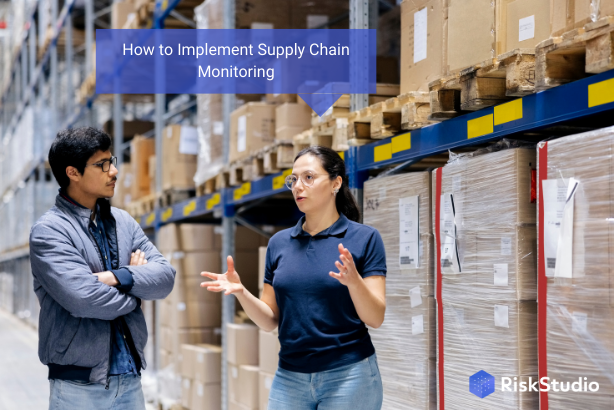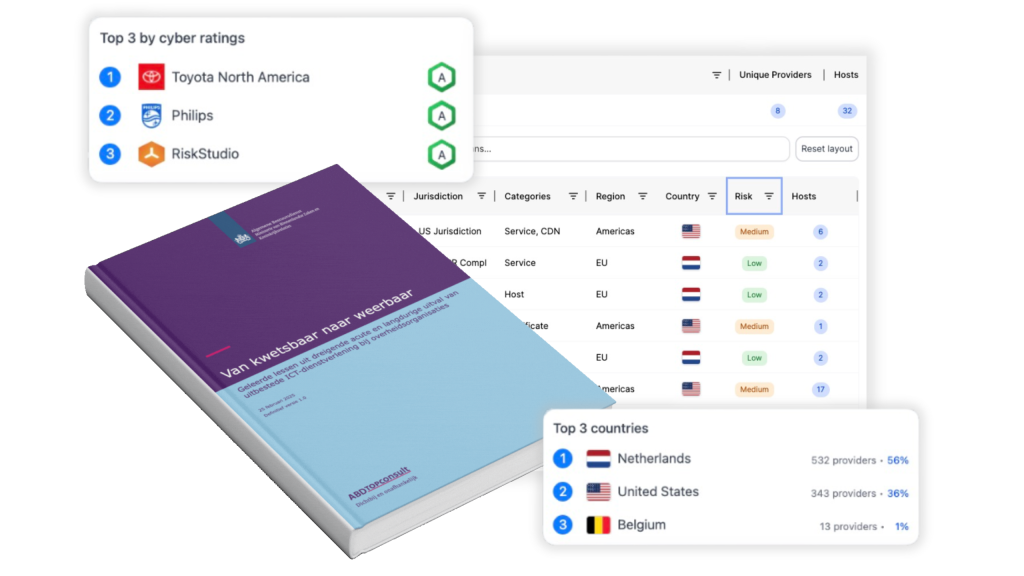Introduction
In today’s digital landscape, managing supply chain security is essential to protect against disruptions, data breaches, and other cyber risks. Implementing supply chain monitoring not only helps identify vulnerabilities but also enables proactive risk management across third-party suppliers. RiskStudio simplifies this process by offering an intuitive platform that provides continuous insights without the need for lengthy questionnaires or access permissions. Here’s a step-by-step guide to implementing effective supply chain monitoring using RiskStudio.
Step 1: Define Your Supply Chain Monitoring Objectives
Before implementing monitoring, it’s important to identify your organization’s goals. Key objectives might include compliance with frameworks like BIO or NIS2, reducing cyber risk exposure from suppliers, or maintaining visibility into critical dependencies within the supply chain.
How RiskStudio Helps:
RiskStudio aligns with regulatory standards and industry best practices, making it easy to set and achieve clear supply chain monitoring goals. The platform’s cyber rating and incident tracking features provide instant, actionable insights tailored to your objectives.
Step 2: Identify and Prioritize Key Suppliers
Create a list of suppliers, especially those that support essential operations or handle sensitive data. Prioritize these suppliers based on their role in your operations and the potential risks they introduce.
How RiskStudio Helps:
Adding suppliers in RiskStudio is straightforward—no questionnaires or approvals required. Simply input your key suppliers, and RiskStudio will begin monitoring their security status, providing fresh ratings and updates daily.
Step 3: Organize Dependencies by Department or Critical Assets
Understanding dependencies is essential for identifying which suppliers are integral to specific departments or critical assets. This allows for targeted monitoring, especially where high-value assets are involved.
How RiskStudio Helps:
RiskStudio allows you to organize supplier dependencies by department or crown jewel assets. This structure enables a clear view of the specific suppliers linked to critical functions, ensuring you can track risks where they matter most.
Step 4: Set Up Real-Time Monitoring and Incident Alerts
Effective supply chain monitoring requires real-time insights and alerts on any incidents that might affect your suppliers. Set up automated alerts to stay informed and respond quickly to any issues that arise.
How RiskStudio Helps:
With RiskStudio, you’ll receive continuous cyber ratings and real-time alerts on major incidents affecting suppliers. These notifications ensure you’re aware of critical issues without manual tracking, so you can act swiftly to mitigate potential impacts.
Step 5: Use Cyber Ratings to Inform Procurement Decisions
Incorporate cybersecurity insights into your procurement process to ensure new suppliers meet your organization’s security standards.
How RiskStudio Helps:
RiskStudio’s daily cyber ratings make it easy to evaluate supplier security postures before making procurement decisions. You can benchmark suppliers and integrate this data into procurement policies to ensure that security remains a priority.
Step 6: Regularly Review and Update Supplier Monitoring
Supply chain risk is dynamic, so it’s important to review and adjust your supplier monitoring approach regularly. Monitor changes in supplier ratings and adjust your risk management approach as necessary.
How RiskStudio Helps:
RiskStudio’s platform automatically updates supplier ratings and tracks historical data, allowing you to continuously monitor and assess suppliers. This ensures your monitoring approach evolves alongside changing risks.
Conclusion:
Implementing supply chain monitoring with RiskStudio is a streamlined, efficient way to protect your organization’s operations and meet compliance standards. Without lengthy questionnaires or the need to enforce access, RiskStudio makes it simple to gain comprehensive insights and manage supplier risks in real time. By following these steps, companies can strengthen their supply chain security and stay prepared in an ever-evolving risk landscape.






